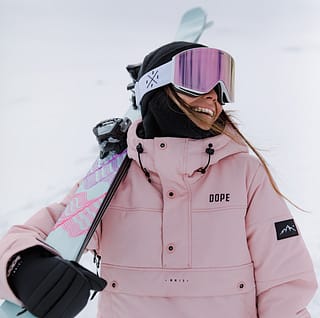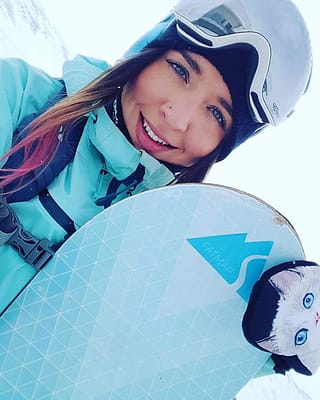Skiing with glasses – The ultimate guide
For a skier who wears prescription glasses and needs them for most activities that require good vision, finding the right skiing glasses is a challenge. That's why we have created this ultimate guide to skiing with glasses.

With the wrong glasses, the entire skiing experience is likely to be uncomfortable. Some glasses get fogged up, and this may compromise one’s vision when skiing, while others have a delicate frame that may get damaged during a skiing adventure.
As you can see, you are likely to experience a handful of challenges when skiing with glasses on. To contend with these challenges, you need a pair of ski goggles that will allow enough space to fit your glasses but at the same time are tight enough to hold them.
In our ultimate guide for skiing with glasses, we want to discover some valuable tips and tricks for all skiers who are dependent on glasses and reveal the best overall ski goggle for skiing with glasses.

The challenges of skiing with glasses
Let’s dive right in and start off with the main challenges of skiing with glasses. The main challenges of skiing with glasses include the following;
- Tight goggles
- Bending of goggle frames
- Glasses being pushed upwards by the goggles
- Glasses pinching tightly at the bridge of your nose
- Glasses slipping downwards
- Fogging
Skiing is an intensive sport with a lot of challenges. A lot is bound to happen when you are skiing downslope with glasses on. They may slip downwards, affecting your vision. If you are not careful, you could lose control and fall.
Another problem is that your glasses may pinch tightly at the bridge of your nose, causing immense discomfort. You’ll not enjoy skiing when such things happen to you.

The main challenge that skiers grapple with when skiing is fogging. When your glasses fog up, your vision becomes blurred. This is extremely dangerous, especially if you are skiing at top speed. You might get into a nasty accident, leaving you with serious injuries.
Having a good set of goggles and glasses can help you avoid these challenges. Fortunately, technology and innovation have made it possible for skiers to wear their glasses while skiing. This ranges from wearing contact lenses to OTG goggles, which can be worn with your prescription glasses.
Types of goggles for skiing with glasses
Over the glasses (OTG goggles) goggles that fit
OTG goggles are oversized goggles that can be worn over prescription glasses. They are not necessarily large, but their design accommodates the glasses perfectly.
The OTG goggles have ample space to fit your glasses comfortably. This protects the frame of your spectacles from damage. Glasses with smaller frames are the best to wear with OTG goggles.
Prescription ski goggle inserts
Prescription inserts also allow you to wear glasses with ski goggles. These are large armless frames that attach to your ski goggles.
Compared to OTG goggles, they offer a wider allowance between your face and the inserts; this prevents fogging of the goggles. Inserts are bought separately from your glasses, but they are standard and will fit in most ski goggles.

Contact lenses for skiing
Wearing eye contact under your ski goggles is a smart move. Your goggles will certainly not damage the contact lenses. Additionally, contacts won’t fog up no matter how fast you ski.
Experts recommend that you wear single-use contacts. Fresh lenses deliver a magnificent vision all day long. It is best to wear contacts with UV light protection. Your eyes will be protected even after removing your goggles over the lunch break.
Prescription sunglasses for warm weather
During the warm weather, you can decide to wear glasses without ski goggles and hit the slopes. You just need to find a way to secure them so that they don’t fall when you hit top speed.
When skiing, you’ll undoubtedly get cold. For that reason, carry your OTG goggles, or the prescription inserts as a backup.
How to keep ski goggles and glasses from fogging
Fogging is a common problem that affects skiers who wear prescribed glasses. It happens when you cover your mouth to avoid the cold. Your warm breath rises to your goggles and causes them to fog up. When this happens, your vision is likely to get impaired, and you can fall or collide with other skiers. A change of temperature may also cause your goggles to fog up.
To keep your glasses from fogging, avoid the cylindrical goggles. Buy spherical goggles, and you’ll have solved half the problem.
Spherical glasses ensure that the distance between your face and the lenses is good enough to prevent fogging.

Another viable option entails investing in goggles with anti-fog lenses. These are designed with unique vents to allow air circulation, which, in turn, minimizes fogging.
When purchasing anti-fogging lenses, bear in mind that cheap lenses may not get the job done.
In case snow settles on the outside of your goggles, desist from wiping it. When you wipe the glasses with your fingers, they are likely to smear. The best solution is to shake off the snow or dab the glasses with a cloth.
Keep your goggles and glasses extremely clean. Water vapor tends to condense on grease or any other kind of dirt on your lenses. Fog will not form on sparkling clean lenses. Manufacturers have clear instructions on how to clean your lenses. All you need to do is strictly adhere to them, and you will keep the fog at bay.
Best overall ski goggles to wear with glasses
There is a variety of ski goggles that you can wear with glasses. Their quality varies as they are manufactured by different brands. While they are all made for a common purpose, some are superior in quality. For instance, the Dope Sight Goggle is the overall best OTG compatible eyewear that you can find in the market. This product is designed and manufactured by Ridestore.

Just because you wear prescription glasses, it doesn’t mean that you can’t enjoy snowboarding or skiing. As explained in this guide, there are a lot of ways to approach skiing with glasses on.
Each one of them has its advantages and disadvantages. The most important thing is to decide what solution works best for you. What works for someone else will not automatically work for you. You may have to try out several options before finding something that works for you.
Interested in the most popular styles for the upcoming snow season?
Find your perfect look at Ridestore now!
Related Reading










